- Home
- Mark R. Levin
Men in Black: How Judges Are Destroying America Page 2
Men in Black: How Judges Are Destroying America Read online
Page 2
This book couldn’t be more timely or important, as liberals continue shamelessly to thwart the people, Congress, the president, and state governments. Increasingly, liberals are also denying the president his judicial appointment power by blocking his well-qualified appointments purely for political reasons. While the informed public—informed primarily thanks to conservative talk radio—understands many of the issues involved in this book, Mark Levin’s Men in Black provides an indispensable historical and constitutional context. And it offers suggested solutions to remedy the serious problems we face. Let me tell you, folks, this is a subject in need of our urgent attention. And this book provides the ammunition you need to defend your liberty.
I am proud to endorse this book by a constitutional scholar, a brilliant lawyer, a pundit extraordinaire, an exceptional radio talk show host, a patriot, and my very good friend. I hope it sells a million and that twice that many read, absorb, and take to heart its critical message.
PREFACE
MEN, NOT GODS
The biggest myth about judges is that they’re somehow imbued with greater insight, wisdom, and vision than the rest of us; that for some reason God Almighty has endowed them with superior judgment about justice and fairness. But the truth is that judges are men and women with human imperfections and frailties. Some have been brilliant, principled, and moral. Others have been mentally impaired, venal, and even racist.
Barely one hundred justices have served on the United States Supreme Court. They’re unelected, they’re virtually unaccountable, they’re largely unknown to most Americans, and they serve for life. They work in a cloistered setting hidden from public view. Yet in many ways the justices are more powerful than members of Congress and the president.
The Supreme Court today is involved in nearly every aspect of modern life, regularly vetoing the decisions of elected federal and state authorities. As few as five justices can and do dictate economic, cultural, criminal, and security policy for the entire nation. So who are these justices? Well, it’s impossible to generalize. But here are some of the more stunning personalities who have served on the Supreme Court:
James Wilson
Wilson was appointed by George Washington in 1789. He had been one of the more influential delegates at the Constitutional Convention, but had serious financial troubles after he was appointed to the Court. He put his money into land speculation, fell into serious debt, and was put in debtor’s prison. He once had his son pay off a creditor so that he—an associate justice of the Supreme Court—could be sprung from jail in Burlington County, New Jersey. Hounded by creditors, Wilson later left his native Pennsylvania and had to live a life on the run. After “holing up in a series of ‘dreary taverns,’” he died broke in North Carolina and was buried in an unmarked grave.1
John Rutledge
Rutledge, too, was appointed by Washington in 1795—by recess appointment—and became the nation’s second chief justice. A United States senator from Rutledge’s native South Carolina wrote that “after the death of his wife, his mind was frequently so much deranged, as to be in a great measure deprived of his senses.”2 There was considerable opposition to Rutledge’s appointment, and he was voted down by the Senate. There had been rumors that his “mind was unsettled” and “he was becoming insane.”3 Rutledge’s depression was so serious that he made two failed suicide attempts, one shortly before and one soon after the Senate rejected his nomination.4
Henry Brockholst Livingston
Appointed by Thomas Jefferson in 1806, Livingston had killed a man in a duel before his appointment to the Court.5
Henry Baldwin
Baldwin was appointed by Andrew Jackson in 1830. In 1832, it was reported that he:
“was seized today with a fit of derangement.” Less than two weeks later Daniel Webster alerted a friend to “the breaking out of Judge Baldwin’s insanity,” and another correspondent observed more pithily that “Judge Baldwin is out of his wits.” Baldwin was hospitalized for what was called “incurable lunacy” and missed the entire 1833 term of Court. Baldwin’s colleague Joseph Story informed Circuit Judge Joseph Hopkinson in May 1833 that “I am sure he cannot be sane. And, indeed, the only charitable view, which I can take of any of his conduct, is, that he is partially deranged at all times.” But Justice Baldwin nonetheless returned to active service on the Supreme Court, and remained a voting member of the Court for eleven more years until his death in April 1844 at age sixty-four.6
Robert C. Grier
Appointed by James Polk in 1846, Grier suffered paralysis in 1867 and thereafter began a slow mental decline. Grier’s case is most troubling because he was the swing vote in one of the more important cases of his era, Hepburn v. Griswold, which struck down the law allowing the federal government to print paper money. “Grier’s demonstration of mental incapacity during the conference discussion was such that every one of his colleagues acknowledged that action had to be taken.”7
Nathan Clifford
Clifford was appointed by James Buchanan in 1858. After a period of mental decline, Clifford suffered a stroke in 1880 just before the beginning of the October term of 1880. “Justice Miller described the situation bluntly: ‘Judge Clifford reached Washington on the 8th [of] October a babbling idiot. I saw him within three hours after his arrival, and he did not know me or any thing, and though his tongue framed words there was no sense in them.’”8 Clifford kept his seat until his death in July 1881.
Stephen J. Field
Field, appointed by Lincoln in 1863, was one of the longest-serving justices. As Chief Justice William Rehnquist has written, at the end of Field’s service, he “became increasingly lame and often seemed lethargic to his colleagues. During the winter of 1896–97 his condition worsened, and his questions in the courtroom indicated that he had no idea of the issues being presented by counsel.”9
Joseph McKenna
McKenna was appointed by William McKinley in 1897, and his mental faculties began to decline as he approached his eighties. After Chief Justice William Taft failed to convince McKenna that it was time to retire, Taft called a meeting of the other justices at his home. They decided they could not allow McKenna to cast the deciding vote in the Court’s decisions. From then on they agreed that if there was a split vote among them, they would change their votes and not allow the case to go forward. The Court did hold a few cases over until McKenna finally agreed to retire in 1924.10
James C. McReynolds
McReynolds, appointed by Woodrow Wilson in 1914, was a notorious anti-Semite. He said he didn’t want the Court “plagued with another Jew.”11 There is no official photograph for the Court for 1924 because McReynolds refused to stand next to Justice Lewis Brandeis, the Court’s first Jewish justice. He would leave the room whenever Brandeis would speak in conference.12 He was also openly hostile toward the second Jewish justice, Benjamin Cardozo. “He often held a brief or record in front of his face when Cardozo delivered an opinion from the bench on opinion day.”13
A McReynolds law clerk, John Knox, also wrote that the justice disapproved of the fact that Knox had been polite to McReynolds’s African American servants, Harry and Mary. McReynolds told him:
I realize that you are a Northerner who has never been educated or reared in the South, but I want you to know that you are becoming much too friendly with Harry. You seem to forget that he is a negro and you are a graduate of the Harvard Law School. And yet for days now, it has been obvious to me that you are, well, treating Harry and Mary like equals. Really, a law clerk to a Justice of the Supreme Court of the United States should have some feeling about his position and not wish to associate with colored servants the way you are doing…. I do wish that you would think of my wishes in this matter in your future relations with darkies.14
Hugo Black
Black, appointed by FDR in 1937, had been a member of the Ku Klux Klan in Alabama.15 He stayed on the Court longer than he should have. In 1969, he suffered a stroke, “resulting in a partial loss of
memory.”16 His health troubles became worse. “In late March 1971, he started having acute pain in his left ear and a chronic headache over his eye and in the back of his head. Aspirin did not help. He found it more difficult to concentrate. His short-term memory was waning. He would latch onto some event of long ago and reminisce. In conference he began to stumble badly, becoming tired and confused, and unable to remember which case was being discussed.”17
Black’s mental decline seemed to lead to paranoia in the months before his resignation and death. “Black was paranoid about the future, expressing fears of governmental collapse; Nixon was preparing a military coup, he said. ‘Anything can happen here. We have small groups fragmenting the government. There may not be a 1972 election—a dictator might take over.’”18
Felix Frankfurter
Frankfurter was appointed by Franklin Roosevelt in 1939. He helped launch the career of the notorious spy Alger Hiss. Frankfurter had been a prominent professor at Harvard Law School. Before joining the Court, he had great influence in getting his law students prestigious clerkships for Supreme Court justices. A notable clerk he obtained for Justice Oliver Wendell Holmes was a student named Alger Hiss. At Frankfurter’s urging, Hiss began a public service career that included service as a delegate to the Yalta Conference, where FDR, Churchill, and Stalin set the boundaries of postwar Europe. Hiss would later be named by Whittaker Chambers as a spy for the Soviet Union. He was tried for perjury, and Frankfurter, in an unprecedented move for a sitting Supreme Court justice, served as a character witness for Hiss at the trial, as did Associate Justice Stanley Reed, another FDR appointee.19 Although Frankfurter obviously would not have known of Hiss’s eventual ties to the Soviet Union as a Communist spy, he knew of the specific charges when he decided to lend the prestige of his high position to Hiss’s defense.
In Brown v. Board of Education, Frankfurter behaved in a manner that most legal ethicists would consider extremely troubling. He collaborated with a former clerk, Philip Elman, who was serving in the solicitor general’s office in the Executive Branch. (That’s the office that represents the administration’s position before the Court.) Frankfurter passed confidential information on to Elman about the positions of his fellow justices in Brown, and advised him on arguments the government should make to sway the Court.20
William O. Douglas
FDR appointed Douglas in 1939. In a particularly bizarre episode, Douglas met a flight attendant on a plane and invited her to visit him at the Court, where he allegedly physically assaulted her.
Just a short time after she had entered Douglas’s chambers, though, members of the staff began hearing strange sounds from inside—shouts, banging furniture, and running feet. A short time later, the office door flew open and out rushed the young woman, her face all flushed and her clothing badly disheveled, shouting at the startled office staff how outraged and disgusted she was. Douglas, she said, had chased her around his desk, grabbing at her clothes and demanding that they go to a motel immediately for a sexual liaison.21
Douglas’s marriages to young women and his subsequent divorces created financial hardship for him, so he sought income to supplement his Court salary. One significant source of income while he was on the bench came from a questionable source:
Newspaper reports had established that over the years Douglas had received $101,000 from the foundation of Albert Parvin. Parvin was the former co-owner of the Flamingo Hotel in Las Vegas and a business associate of Meyer Lansky, “Ice Pick Willie” Alderman, and others not usually placed within the category of “nice Jewish boys.”22
In his last year on the Court, Douglas also suffered, at times, from delusion: “A 1974 stroke incapacitated William O. Douglas at the age of 76 for 2 ½ months, though he told the press he had been hurt in a fall. Afterwards, he slurred his words, couldn’t walk, developed fears that people were trying to kill him, thought he was chief justice and spurned pleas that he quit.”23 Things were so bad that the justices themselves took action: “His refusal to step down despite obvious mental and physical problems led colleagues to decide secretly to stop counting his vote in some cases, until he finally quit at the insistence of his wife and friends,”24 some ten months after the stroke.
Charles Whittaker
Whittaker, appointed by Eisenhower in 1957, was said to be vacillating and indecisive. The pressures of the Court led him to a nervous breakdown and retirement after five years of service.25
Abe Fortas
LBJ appointed Fortas to the Court in 1965. He continued to act as an advisor to Johnson while on the Court. He supplemented his Court salary ($39,500 at the time) by taking money from a foundation set up by a convicted “stock swindler.” Fortas “resigned from the Supreme Court after it was revealed that while on the bench he had pocketed a $20,000 retainer from the foundation of jailed financier Louis Wolfson.”26
He found a cash cushion in a $20,000-a-year consulting fee from Louis Wolfson, a Florida businessman who was under investigation by the SEC for alleged stock improprieties. In setting the terms for the fee—ostensibly to compensate him for occasional advice to Wolfson’s philanthropic foundation and companies—Fortas arranged for [Fortas’s wife] Agger to receive the $20,000 each year after his death. In exchange, Fortas had to attend a single annual meeting. (And of course, it was possible that one of Wolfson’s cases would end up affected by a decision of the Court.)…[T]wo weeks to the day after the first check was sent, Fortas was writing the White House to boost two of Wolfson’s companies—both of which were under federal investigation at the time. It was a quiet deal, and became public only when Johnson tried to make Fortas chief justice in 1968. Fortas, finding himself facing impeachment rather than promotion, resigned.27
Thurgood Marshall
Marshall, appointed by LBJ in 1967, stayed on the Court too long. In his final years on the Court, he became indifferent to his judicial duties—he reportedly left much of the writing of opinions to his clerks and sometimes didn’t bother to read the briefs submitted by counsel. Instead, he apparently spent many hours watching television in his chambers, especially soap operas.28People magazine had called him a devotee of Days of Our Lives as early as 1982,29 and he once told fellow justice William Brennan that you could learn a lot about life from soap operas.30 Despite the fact that he wasn’t quite giving it his all, he didn’t want to leave, since he would probably be replaced by a conservative. “But despite poor health in recent years—his eyesight is failing, he wears a hearing aid, and he broke his hip in a fall last year—he was determined to keep his seat as long as the likely replacement was another conservative nominee. With cantankerous tongue in cheek, Marshall would tell his clerks, ‘If I die, prop me up and keep on voting.’”31
In his waning years, Marshall would disparage the framers of the Constitution. At a speech in Hawaii, he said, in part:
I do not believe that the meaning of the Constitution was forever “fixed” at the Philadelphia Convention…. Nor do I find the wisdom, foresight and sense of justice exhibited by the framers particularly profound. To the contrary, the government they devised was defective from the start, requiring several amendments, a civil war and momentous social transformation to attain the system of constitutional government, and its respect for the individual freedoms and human rights, we hold as fundamental today. They could not have imagined, nor would they have accepted, that the document they were drafting would one day be construed by a Supreme Court to which had been appointed a woman and the descendant of an African slave. “We the people” no longer enslave, but the credit does not belong to the framers. It belongs to those who refused to acquiesce in outdated notions of “liberty,” “justice” and “equality,” and who strived to better them.32
Marshall couldn’t have been more wrong, and couldn’t have had a weaker grasp of the Constitution. The Constitution established principles of governance. Discrimination, injustice, and inhumanity are not products of the Constitution. To the extent they exist, they result from man’s
imperfection. Consequently, slavery exists today not in the United States but in places like Sudan. Indeed, the evolution of American society has only been possible because of the covenant the framers adopted, and the values, ideals, and rules set forth in that document.
Many truly great individuals have served on the Supreme Court. Many great rulings have been issued by the Court. But the justices have been frequently and wrongly deified. They have co-opted authority that has not been granted to them; they have usurped the authority that has been granted to Congress, the president, and the states; and they continually behave like an Olympian council.
Men in Black, which refers to the men and women who serve as judges and justices on the federal bench, tells the story of how America has turned from the most representative form of government to a de facto judicial tyranny. From same-sex marriage, illegal immigration, and economic socialism to partial-birth abortion, political speech, and terrorists’ “rights,” judges have abused their constitutional mandate by imposing their personal prejudices and beliefs on the rest of society. And we, the people, need not stand for it.

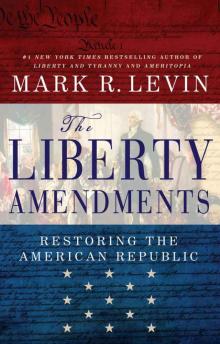 The Liberty Amendments: Restoring the American Republic
The Liberty Amendments: Restoring the American Republic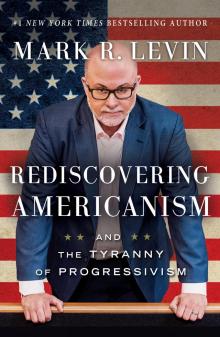 Rediscovering Americanism: And the Tyranny of Progressivism
Rediscovering Americanism: And the Tyranny of Progressivism Plunder and Deceit: Big Government's Exploitation of Young People and the Future
Plunder and Deceit: Big Government's Exploitation of Young People and the Future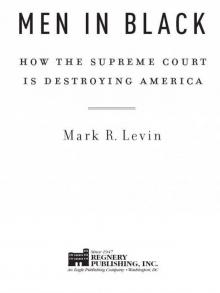 Men in Black: How Judges Are Destroying America
Men in Black: How Judges Are Destroying America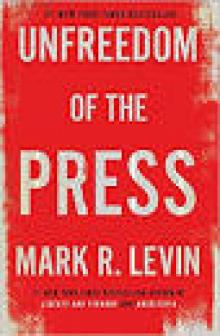 Unfreedom of the Press
Unfreedom of the Press Ameritopia: The Unmaking of America
Ameritopia: The Unmaking of America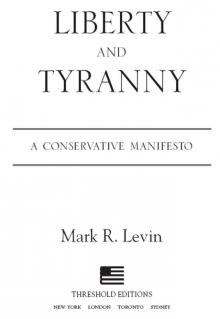 Liberty and Tyranny
Liberty and Tyranny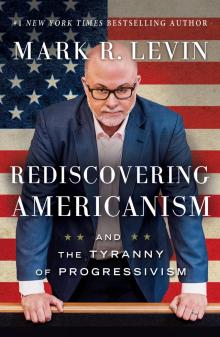 Rediscovering Americanism
Rediscovering Americanism Ameritopia
Ameritopia Plunder and Deceit
Plunder and Deceit